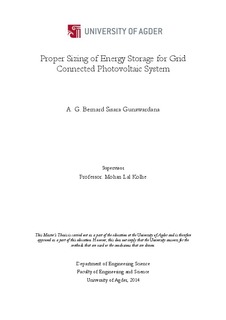| dc.description.abstract | The requirement of an energy storage to a grid connected PV system, is highly desirable in cases like power outages. Another importance is to reduce the peak time electricity buying from the utility grid and discharging the battery stored energy to the load. This project investigates the optimum dimensioning of a battery energy storage in a grid connected Photovoltaic system, for the customers who purchase and sell the electricity to the utility grid. The aim was to provide an optimal method that helps electricity customers equipped with PV systems, in making decisions to install economically sized battery energy storage. This study used the load, PV and the utility electricity tariff data of a typical customer, during a typical year. The daily average load demand of the customer is found as 27.31 kWh. The PV system installed on the rooftop of the customer’s residence is determined as a 5kWP system. The daily average PV production is found as 20.69 kWh. The energy flow decision program of the grid connected PV system was developed with the comparison of available PV power and the load demand. According to the peak and off peak hours, the decision was changed to minimize the operating cost of the grid connected PV system with battery energy storage. The energy flow decision programme of the PV system was realized in the Matlab software. Optimizing the energy flow schedule performed under two different energy flow control strategies as case A and case B. Under the Case A, the battery energy has been released to the utility grid, during the daytime, only up to a predefined value of the state of charge. Under the Case B, the battery is allowed to discharge its energy on peak hours, even up to the minimum charge state. The optimum battery capacity relevant to the case A and B, were calculated as 14.4 kWh and 19.2 kWh respectively. These results represented that, proper sizing the battery used in grid connected PV system extremely depend on the electricity tariff and the battery degradation cost. When compared both the cases in one for one tariff scheme, case A was much beneficial to adopt. The case B generated higher financial benefits compared to case A, when incentives were given in feed in tariff or for the battery investment cost. When considered the one for one tariff scheme, the PV system without the battery energy storage was much more beneficial to adopt by the financial point of view, but not from the operational point of view. | nb_NO |
